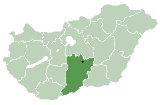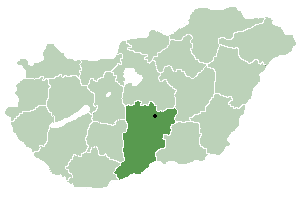
Homokmégy
Encyclopedia

Village
A village is a clustered human settlement or community, larger than a hamlet with the population ranging from a few hundred to a few thousand , Though often located in rural areas, the term urban village is also applied to certain urban neighbourhoods, such as the West Village in Manhattan, New...
and municipality
Municipality
A municipality is essentially an urban administrative division having corporate status and usually powers of self-government. It can also be used to mean the governing body of a municipality. A municipality is a general-purpose administrative subdivision, as opposed to a special-purpose district...
in Bács-Kiskun
Bács-Kiskun
Bács-Kiskun is a county located in southern Hungary. It was created as a result of World War II, merging the pre war Bács-Bodrog and the southern parts of Pest-Pilis-Solt-Kiskun counties. With an area of 8,445 km2, Bács-Kiskun is the largest county in the country. The terrain is mostly flat...
county, in the Southern Great Plain
Southern Great Plain
Southern Great Plain is a statistical region of Hungary. It is part of Great Plain and North region. Southern Great Plain includes the 3 counties:* Bács-Kiskun* Békés* Csongrád...
region
Region
Region is most commonly found as a term used in terrestrial and astrophysics sciences also an area, notably among the different sub-disciplines of geography, studied by regional geographers. Regions consist of subregions that contain clusters of like areas that are distinctive by their uniformity...
of southern Hungary
Hungary
Hungary , officially the Republic of Hungary , is a landlocked country in Central Europe. It is situated in the Carpathian Basin and is bordered by Slovakia to the north, Ukraine and Romania to the east, Serbia and Croatia to the south, Slovenia to the southwest and Austria to the west. The...
.
Village history
Őrjeg raised from one-time branch of river Danube (Sár, Turján, Red marsh) as a boundary of eastern land created a closed area, which probably is the same as 'Big island' written by Anonymous and stayed by princely dynasty.Water-shaped characteristic of this area was considerably changed by protections against floods lasting since beginning of the last century. Nowadays only geographical names of the village boundary remind us of the old water world. Mostly we can see tillages besides the peatery, meadows and pastures everywhere.
In 1877, Roman Catholic presbytery was founded, its register of birth have been guided since 1877. In 1878, the new church was consecrated in honour of St. Adalbert.
In 1938, Gyula László excavated a cemetery from Avar age in Halom. Material of this excavation was preserved in Hungarian National Museum.
After 1945, infrastructure of the village improved a lot (electricity, kindergarten, library, flats, artesian well, and groceries).
From 1954 till 1973: several folk music researcher and collector visited the village.
In 1963: One of collection point of Hungarian Ethnographical Atlas was Homokmégy.
In 1996: Tombs from 10-11 century were dug beside the Alsómégy-Homokmégy dirt road. Őrjeg - with its peateries, pastures, grasslands almost on 1000 - was pronounced a nature conservation area in 1997.
Domestic industry of embroidery of this place is considerable; birthplace of famous egg-painter, embroiderer women is Homokmégy. Recently, hunting tourism becomes more considerable in the village life.
Geography
It covers an areaArea
Area is a quantity that expresses the extent of a two-dimensional surface or shape in the plane. Area can be understood as the amount of material with a given thickness that would be necessary to fashion a model of the shape, or the amount of paint necessary to cover the surface with a single coat...
of 70.33 km² and has a population
Population
A population is all the organisms that both belong to the same group or species and live in the same geographical area. The area that is used to define a sexual population is such that inter-breeding is possible between any pair within the area and more probable than cross-breeding with individuals...
of 1544 people (2002).

